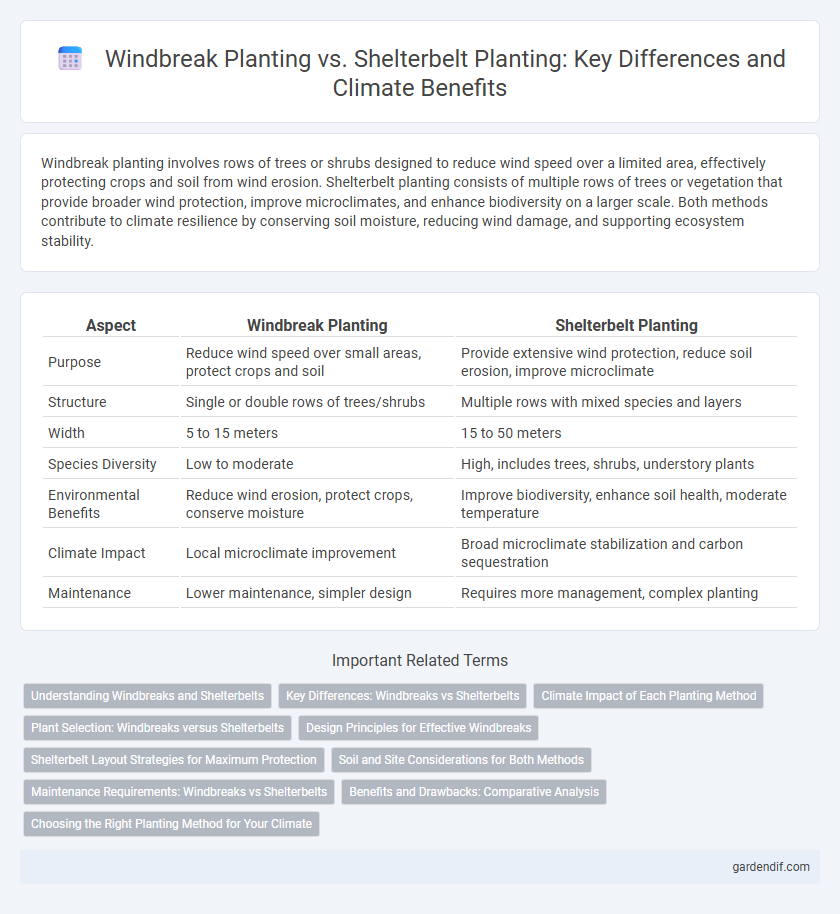
Windbreak planting vs Shelterbelt planting Illustration
Windbreak planting involves rows of trees or shrubs designed to reduce wind speed over a limited area, effectively protecting crops and soil from wind erosion. Shelterbelt planting consists of multiple rows of trees or vegetation that provide broader wind protection, improve microclimates, and enhance biodiversity on a larger scale. Both methods contribute to climate resilience by conserving soil moisture, reducing wind damage, and supporting ecosystem stability.
Table of Comparison
| Aspect | Windbreak Planting | Shelterbelt Planting |
|---|---|---|
| Purpose | Reduce wind speed over small areas, protect crops and soil | Provide extensive wind protection, reduce soil erosion, improve microclimate |
| Structure | Single or double rows of trees/shrubs | Multiple rows with mixed species and layers |
| Width | 5 to 15 meters | 15 to 50 meters |
| Species Diversity | Low to moderate | High, includes trees, shrubs, understory plants |
| Environmental Benefits | Reduce wind erosion, protect crops, conserve moisture | Improve biodiversity, enhance soil health, moderate temperature |
| Climate Impact | Local microclimate improvement | Broad microclimate stabilization and carbon sequestration |
| Maintenance | Lower maintenance, simpler design | Requires more management, complex planting |
Understanding Windbreaks and Shelterbelts
Windbreaks consist of single or multiple rows of trees or shrubs strategically planted to reduce wind speed and protect soil and crops, enhancing microclimate conditions. Shelterbelts are broader, multi-row vegetative barriers designed not only to moderate wind but also to improve biodiversity, reduce erosion, and create habitats for wildlife. Understanding the structural differences and ecological functions of windbreaks and shelterbelts is crucial for effective climate adaptation and sustainable agricultural practices.
Key Differences: Windbreaks vs Shelterbelts
Windbreak planting consists of a single row of trees or shrubs designed primarily to reduce wind speed and protect crops or soil from erosion, while shelterbelt planting involves multiple rows that provide broader protection and enhance biodiversity. Windbreaks are typically narrower and offer localized microclimate improvements, whereas shelterbelts create extensive barriers influencing larger areas and supporting wildlife habitats. The density, row arrangement, and ecological functions distinctly separate windbreaks from shelterbelts in climate impact and land management.
Climate Impact of Each Planting Method
Windbreak planting significantly reduces soil erosion and microclimate temperature extremes by creating dense, single-row barriers that block wind flow, directly enhancing local climate resilience. Shelterbelt planting, characterized by multiple rows of diverse tree species, promotes greater carbon sequestration and biodiversity while moderating wind speed over larger areas, contributing to regional climate regulation. Both methods improve air quality and stabilize local weather patterns but differ in scale and ecosystem services, with shelterbelts offering broader climate mitigation benefits.
Plant Selection: Windbreaks versus Shelterbelts
Windbreak planting prioritizes fast-growing species with dense foliage to maximize immediate wind reduction, often incorporating evergreen trees such as spruces or pines for year-round protection. Shelterbelt planting emphasizes a diverse mix of tree and shrub species, combining evergreens and deciduous plants like poplars and willows to create layered barriers that support biodiversity and offer seasonal wind control. Both strategies optimize plant selection based on local climate, soil conditions, and the specific microclimate benefits desired.
Design Principles for Effective Windbreaks
Effective windbreak design principles prioritize species diversity, spacing, and height to maximize wind reduction and soil erosion prevention. Windbreak planting typically involves single or double rows of fast-growing trees or shrubs strategically spaced to slow wind velocity, while shelterbelt planting incorporates multiple rows with a mix of tall, medium, and low vegetation for layered protection. Optimal orientation perpendicular to prevailing winds and consideration of local climate conditions enhance the shelterbelt's efficacy in microclimate regulation and crop yield improvement.
Shelterbelt Layout Strategies for Maximum Protection
Shelterbelt planting employs strategic layout designs such as multi-row configurations and species diversity to optimize wind reduction and soil erosion prevention. Proper spacing and orientation relative to prevailing wind directions enhance the microclimate by decreasing wind speed and moisture loss over agricultural fields. Incorporating native trees and shrubs in staggered rows increases structural complexity, improving shelterbelt effectiveness and promoting biodiversity.
Soil and Site Considerations for Both Methods
Windbreak planting and shelterbelt planting both enhance soil stability and microclimate regulation but differ in spatial arrangement and species selection based on site conditions. Windbreaks typically require well-drained soils and wider spacing to optimize wind reduction, while shelterbelts favor varied soil types with closer, multi-row plantings to maximize protection and biodiversity. Site topography, soil texture, and moisture availability critically influence the choice of species and planting patterns, ensuring effective erosion control and improved soil health.
Maintenance Requirements: Windbreaks vs Shelterbelts
Windbreaks typically require less maintenance due to their simpler structure and fewer plant species compared to shelterbelts, which consist of multiple tree rows and diverse vegetation demanding regular pruning and pest management. Shelterbelts often need frequent monitoring to ensure optimal growth and health, especially in varying climate conditions that can stress different species. Effective maintenance of shelterbelts enhances their long-term wind protection and biodiversity benefits, while windbreaks offer a lower-maintenance solution for immediate wind reduction.
Benefits and Drawbacks: Comparative Analysis
Windbreak planting typically involves a single row of trees or shrubs that reduce wind speed and protect crops, offering benefits such as lower soil erosion and enhanced microclimate but limited biodiversity and less effective long-term wind control. Shelterbelt planting consists of multiple tree rows creating a dense barrier that significantly reduces wind impact, improves wildlife habitat, and increases carbon sequestration, though it requires more land, higher initial investment, and potential shading effects on adjacent crops. Comparing both, windbreaks are cost-effective for smaller areas with quick implementation, while shelterbelts provide stronger environmental benefits and ecosystem services at a higher resource demand.
Choosing the Right Planting Method for Your Climate
Selecting between windbreak and shelterbelt planting depends on your region's climate factors such as wind speed, precipitation patterns, and temperature extremes. Windbreaks are ideal for reducing wind velocity and soil erosion in open, arid landscapes, while shelterbelts provide multi-layered protection against harsh weather in temperate zones. Assessing local microclimates ensures optimal tree species and spacing, maximizing environmental benefits and crop yields.
Windbreak planting vs Shelterbelt planting Infographic

 gardendif.com
gardendif.com